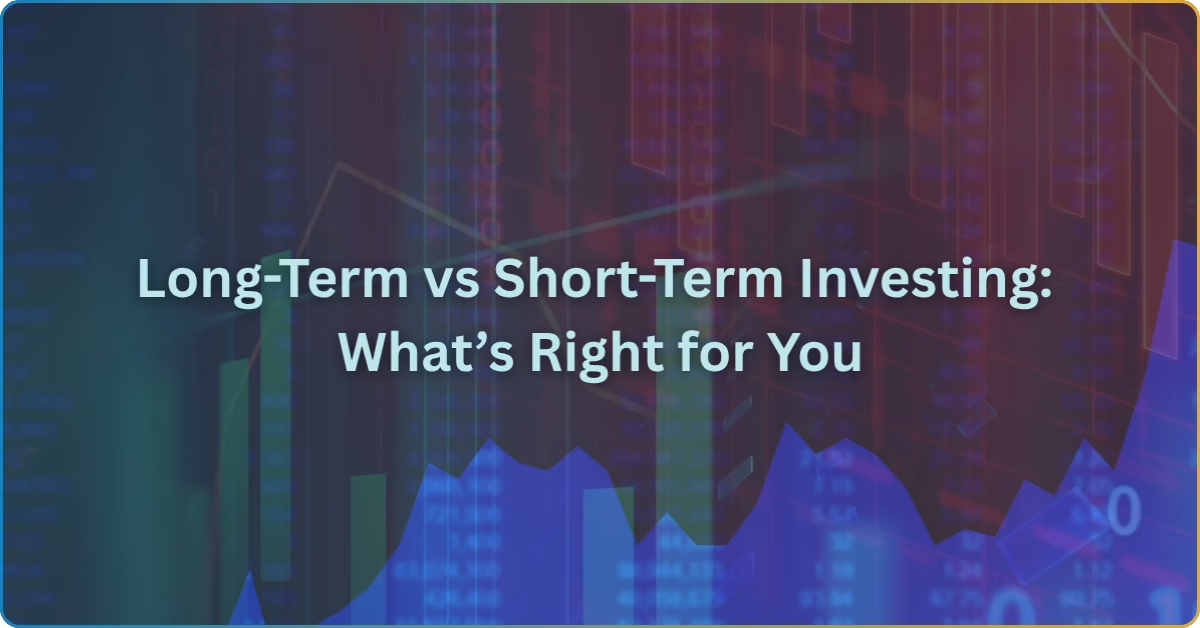Building a solid investment portfolio starts with clarifying your goals, risk tolerance, time frame, and desired investments. Hence, understanding the difference between long-term vs short-term investing is essential to ensure that your portfolio aligns with your goals.
Here, let’s talk about long-term vs short-term investing and how they differ from each other, the advantages and disadvantages, and which is better, long-term vs short-term investing.
Understanding Long-Term Investment
Long-term investors are people who invest in financial instruments that they hold for more than 1 year. Examples of long-term investments include bonds, stocks, and derivatives. This approach is based on the principle of spending “time in” the market instead of “timing” the market.
The goal of long-term investment is a higher return due to the longer time the investment is held and the associated compound growth, which refers to the return on the returns you put back into your investment.
One of the most recognized long-term investments is a personal pension plan. In this plan, you add money to the fund, which you cannot access until you reach a certain age, regardless of whether you contribute regularly or not.
Some long-term investors choose to place their money in higher-risk options. This practice is done because the money may have better growth over time, and you can also recover any losses. However, this is risky because all investments can go up and down, which means you may get back less than what you put in.
Advantages of Long-Term Investing
Here are some of the advantages of long-term investing:
Potential of Growth Over Time
Unlike short-term investing, long-term investing has potential for market growth. Stock markets can fluctuate daily, especially during volatile periods, even though the overall trend is increasing.
Hence, holding an investment that spans 5-10 years could increase the potential for a higher return due to compound growth.
Pound Cost Averaging
Dollar cost averaging refers to the potential benefits of regular investments over those of a single lump sum. It works on the basis that steady investments can reduce the impact of a market downturn, which investing in a lump sum might expose you to.
This approach indicates that you continually invest regardless of whether the markets rise or fall. It allows you to buy more assets when prices are low and fewer when prices are high.
Potentially Less Risk
No investment is totally free of risk, but long-term investing can be less hazard-prone than short-term investing. A longer time frame allows your money the chance to ride out market changes and volatility. It also gives your investment a chance to recover from short-term losses because of its long time frame.
Disadvantages of Long-Term Investing
Here are some of the disadvantages of long-term investments:
Opportunity Cost
Opportunity cost refers to the potential benefits an investor misses out on when they choose to invest in a long-term investment over other options. This means missing out on higher yield, potential gains, and the ability to react to the changes in the market in short-term investing.
Limited Liquidity
Investors may find it difficult to access their money for emergencies and other immediate needs from long-term investments because of limited liquidity. Some long-term investments even require a penalty for early withdrawal.
Low Reward
The earnings of your investment could be degraded due to inflation over the period you hold it. Thus, chances for a huge gain are much smaller in long-time investments than in short-term investments.
Understanding Short-Term Investment
Short-term investments are financial investments that can be converted to cash in a relatively short time, typically within one year. A lot of short-term investments are even sold or converted to cash in 3 months to 1 year.
Short-term investments are also known as marketable securities or temporary investments. Examples of the best short term investments are ultra-short-term bonds, capital or convertible notes, and the money market.
Short-term investments can also refer to financial assets owned by a company. In this context, short-term investments refer to investments a company has made that can be converted into cash within 1 year.
Advantages of Short-Term Investment
Here are the advantages of short-term investment:
Potential for Quick Profit
Given that short-term investments can be liquidated within 1year, there is potential for quick profit compared to long-term investments.
Highly Liquid
Short-term investments are highly liquid, which gives investors the flexibility of making money that they can withdraw quickly if they need it.
Disadvantages of Short-Term Investment
Here are some of the disadvantages of short-term investing:
Very Risky
If the stock you invested in dipped, or if you missed the best time to sell, then you may be at a loss instead of earning.
Higher Tax
Short-term investments are taxed like regular income. Therefore, if you make a huge amount of money off your short-term investments, you may be bumping yourself into a new tax bracket, which may eat into your earnings.
Requires Active Management
Since short-term investing is highly risky and is subject to market volatility, you should always be on your toes. It requires precise market timing to avoid selling at a loss.
Long-Term vs Short-Term Investing: A Side-by-Side Comparison
Now that we know the definition of long-term and short-term investments, let’s look at their differences. Here is a table showing the aspects in which long-term and short-term investing differ from each other:
| Aspect | Short-Term Investments | Long-Term Investments |
| Accounting treatment | Current assets | Non-current or long-term assets |
| Purpose | Manage cash flow and ensure liquidity | Strategic growth and expansion |
| Risk level | Lower risk due to shorter holding period and higher liquidity | Vary from moderate to high risk depending on the type of investment and market conditions |
| Return on investment | Lower returns due to the lower risk and shorter duration | Potentially higher returns due to longer holding period and compounding effects |
| Liquidity | Highly liquid | Less liquid |
| Tax Implications | Gains may be taxed at a lower short-term capital gains rate | Gains may be taxed at a long-term capital gains rate |
| Time Frame | Less than 1 year | More than 1 year |
| Volatility | Less volatile | More volatile, depending on the nature of the investment and market fluctuations |
Another difference between long-term vs short-term investing is the investment goals. Long-term investors typically have goals that take years to reach. Long term investment plans may include retirement and saving for college.
Meanwhile, short term investment plans may take months or a few years. Examples of short-term goals include saving for a house, a car, a vacation, a wedding, or a home improvement.
You may also be asking…
What are short-term and long-term investment examples?
Examples of short term investment options are certificates of deposit, money market accounts, treasuries, bond funds, municipal bonds, peer-to-peer lending, and Roth IRAs.
Meanwhile, examples of long-term investments are real estate, bonds, and stocks.
What is the difference between trading and investing in stock market?
Although “investing” and “trading” are often used interchangeably, these terms represent different approaches in financial markets.
Investing is typically a long-term approach that is focused on gradually building wealth. It is generally used for goals like retirement. In contrast, trading takes advantage of the movements of short-term markets for more frequent but small earnings.
To determine which one of the two approaches is the best fit for you, you need to decide on your financial goals, risk tolerance, time frame, and market knowledge.
The Bottomline
So, in the discussion of long-term vs short-term investing, which one is ideal for you? There’s no single “right” answer on which is better, long-term vs short-term investing. It all depends on your investment goals, time frame, and risk tolerance.
If your goal is to gradually accumulate wealth and you like a passive financial strategy, long-term investing might be ideal for you. This approach is perfect for people with major goals like education and retirement.
Conversely, if you possess a greater risk tolerance and seek quicker returns, short-term investing might be more appropriate for you. Nonetheless, it’s important to keep in mind the dangers and possible setbacks you might encounter.
Many investors do both long-term and short-term investments to diversify their portfolio, aiming for a balance. This allows them to achieve stability through long-term holdings while taking advantage of short-term opportunities for additional income.
If you enjoyed this comparison between long-term vs short-term investing and would like to keep informed about different investment strategies, CommuniTrade is a space where verified traders share information about trading topics. Get access to insightful tips, financial mentor advice, and more exclusive perks that await.

















